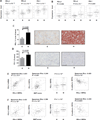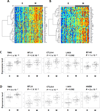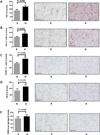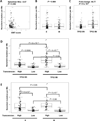Epithelial-Mesenchymal Transition Is Associated with a Distinct Tumor Microenvironment Including Elevation of Inflammatory Signals and Multiple Immune Checkpoints in Lung Adenocarcinoma
- PMID: 26851185
- PMCID: PMC4947453
- DOI: 10.1158/1078-0432.CCR-15-1434
Epithelial-Mesenchymal Transition Is Associated with a Distinct Tumor Microenvironment Including Elevation of Inflammatory Signals and Multiple Immune Checkpoints in Lung Adenocarcinoma
Abstract
Purpose: Promising results in the treatment of non-small cell lung cancer (NSCLC) have been seen with agents targeting immune checkpoints, such as programmed cell death 1 (PD-1) or programmed death ligand-1 (PD-L1). However, only a select group of patients respond to these interventions. The identification of biomarkers that predict clinical benefit to immune checkpoint blockade is critical to successful clinical translation of these agents.
Methods: We conducted an integrated analysis of three independent large datasets, including The Cancer Genome Atlas of lung adenocarcinoma and two datasets from MD Anderson Cancer Center (Houston, TX), Profiling of Resistance Patterns and Oncogenic Signaling Pathways in Evaluation of Cancers of the Thorax (named PROSPECT) and Biomarker-Integrated Approaches of Targeted Therapy for Lung Cancer Elimination (named BATTLE-1). Comprehensive analysis of mRNA gene expression, reverse-phase protein array, IHC, and correlation with clinical data were performed.
Results: Epithelial-mesenchymal transition (EMT) is highly associated with an inflammatory tumor microenvironment in lung adenocarcinoma, independent of tumor mutational burden. We found immune activation coexistent with elevation of multiple targetable immune checkpoint molecules, including PD-L1, PD-L2, PD-1, TIM-3, B7-H3, BTLA, and CTLA-4, along with increases in tumor infiltration by CD4(+)Foxp3(+) regulatory T cells in lung adenocarcinomas that displayed an EMT phenotype. Furthermore, we identify B7-H3 as a prognostic marker for NSCLC.
Conclusions: The strong association between EMT status and an inflammatory tumor microenvironment with elevation of multiple targetable immune checkpoint molecules warrants further investigation of using EMT as a predictive biomarker for immune checkpoint blockade agents and other immunotherapies in NSCLC and possibly a broad range of other cancers. Clin Cancer Res; 22(14); 3630-42. ©2016 AACRSee related commentary by Datar and Schalper, p. 3422.
©2016 American Association for Cancer Research.
Figures






Comment in
-
Epithelial-Mesenchymal Transition and Immune Evasion during Lung Cancer Progression: The Chicken or the Egg?Clin Cancer Res. 2016 Jul 15;22(14):3422-4. doi: 10.1158/1078-0432.CCR-16-0336. Epub 2016 Apr 13. Clin Cancer Res. 2016. PMID: 27076625 Free PMC article.
Similar articles
-
PD-L1 expression is associated with epithelial-to-mesenchymal transition in adenocarcinoma of the lung.Hum Pathol. 2016 Dec;58:7-14. doi: 10.1016/j.humpath.2016.07.007. Epub 2016 Jul 26. Hum Pathol. 2016. PMID: 27473266
-
Triple blockade of Ido-1, PD-L1 and MEK as a potential therapeutic strategy in NSCLC.J Transl Med. 2022 Nov 22;20(1):541. doi: 10.1186/s12967-022-03730-y. J Transl Med. 2022. PMID: 36419183 Free PMC article.
-
LFG-500, a novel synthetic flavonoid, suppresses epithelial-mesenchymal transition in human lung adenocarcinoma cells by inhibiting NLRP3 in inflammatory microenvironment.Cancer Lett. 2017 Aug 1;400:137-148. doi: 10.1016/j.canlet.2017.04.035. Epub 2017 Apr 29. Cancer Lett. 2017. PMID: 28461245
-
Predictive biomarkers of response to PD-1/PD-L1 immune checkpoint inhibitors in non-small cell lung cancer.Lung Cancer. 2016 Sep;99:79-87. doi: 10.1016/j.lungcan.2016.06.016. Epub 2016 Jun 21. Lung Cancer. 2016. PMID: 27565919 Free PMC article. Review.
-
Biomarkers for PD-1/PD-L1 Blockade Therapy in Non-Small-cell Lung Cancer: Is PD-L1 Expression a Good Marker for Patient Selection?Clin Lung Cancer. 2016 Sep;17(5):350-361. doi: 10.1016/j.cllc.2016.03.011. Epub 2016 Apr 6. Clin Lung Cancer. 2016. PMID: 27137346 Review.
Cited by
-
Density, Distribution, and Composition of Immune Infiltrates Correlate with Survival in Merkel Cell Carcinoma.Clin Cancer Res. 2016 Nov 15;22(22):5553-5563. doi: 10.1158/1078-0432.CCR-16-0392. Epub 2016 May 10. Clin Cancer Res. 2016. PMID: 27166398 Free PMC article.
-
Circ_BBS9 as an early diagnostic biomarker for lung adenocarcinoma: direct interaction with IFIT3 in the modulation of tumor immune microenvironment.Front Immunol. 2024 Jul 19;15:1344954. doi: 10.3389/fimmu.2024.1344954. eCollection 2024. Front Immunol. 2024. PMID: 39139574 Free PMC article.
-
Circulating tumor cell methylation profiles reveal the classification and evolution of non-small cell lung cancer.Transl Lung Cancer Res. 2022 Feb;11(2):224-237. doi: 10.21037/tlcr-22-50. Transl Lung Cancer Res. 2022. PMID: 35280307 Free PMC article.
-
Controversies around epithelial-mesenchymal plasticity in cancer metastasis.Nat Rev Cancer. 2019 Dec;19(12):716-732. doi: 10.1038/s41568-019-0213-x. Epub 2019 Oct 30. Nat Rev Cancer. 2019. PMID: 31666716 Free PMC article. Review.
-
Tumor-immune microenvironment revealed by Imaging Mass Cytometry in a metastatic sarcomatoid urothelial carcinoma with a prolonged response to pembrolizumab.Cold Spring Harb Mol Case Stud. 2022 Apr 28;8(3):a006151. doi: 10.1101/mcs.a006151. Print 2022 Apr. Cold Spring Harb Mol Case Stud. 2022. PMID: 35483877 Free PMC article.
References
-
- Lynch TJ, Bondarenko I, Luft A, Serwatowski P, Barlesi F, Chacko R, et al. Ipilimumab in combination with paclitaxel and carboplatin as first-line treatment in stage IIIB/IV non-small-cell lung cancer: results from a randomized, double-blind, multicenter phase II study. Journal of clinical oncology : official journal of the American Society of Clinical Oncology. 2012;30:2046–2054. - PubMed
MeSH terms
Substances
Grants and funding
LinkOut - more resources
Full Text Sources
Other Literature Sources
Medical
Research Materials

